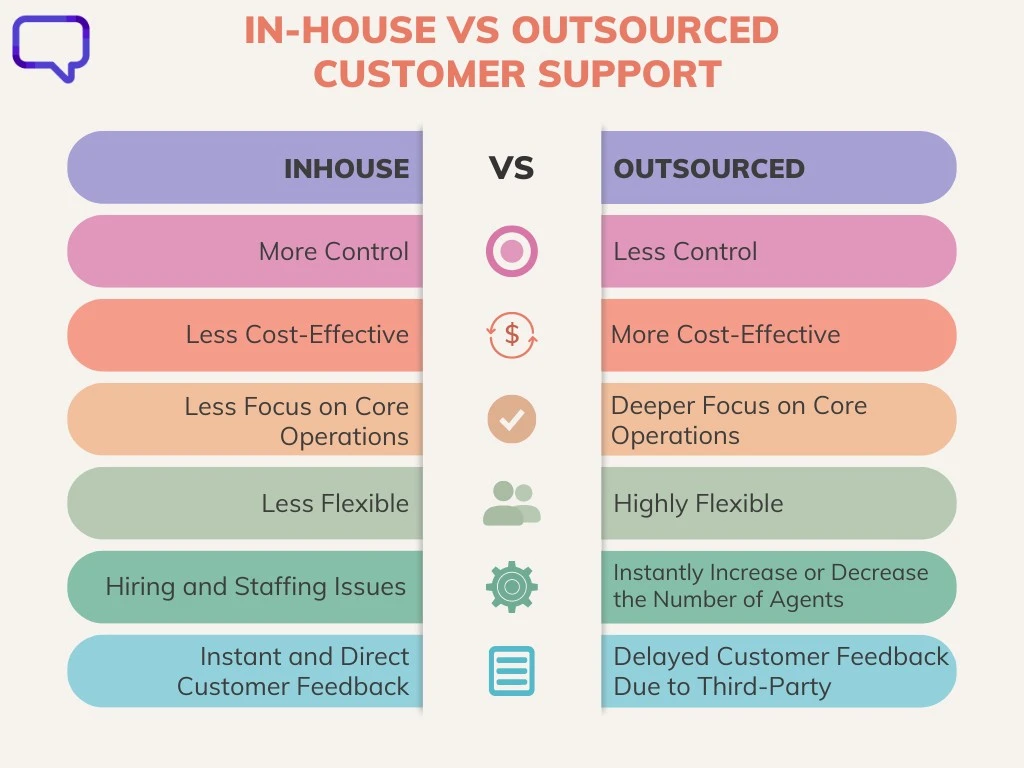There’s a common misconception among the business community that an in-house customer support department performs better than an outsourced one. That’s not true. Nor is it true that outsourced customer service will outshine an in-house team ten out of ten times. The success of your customer support team depends on multiple factors ranging from the size of your company to the cost you can afford. In this blog, I hope to put an end to the in-house vs outsourced customer support debate by sharing my years of experience in the outsourcing industry.
Table of Contents
Customer support is not limited to answering queries of customers and resolving their issues.
One of the most important components of modern day CS is proactive support. That means guiding a potential customer throughout their journey.
This not only shapes the experiences that customers have with a brand, but also impacts customer loyalty and builds a positive relation with them as well.
The challenge for businesses is to decide how to manage this crucial function.
They can either hire and manage a team internally, referred to as in-house customer support, or they can contract this service to an expert third-party provider, known as outsourcing.
Each of these models has its pros and cons, and the decision often hinges on a multitude of factors.
One of the most prominent of these factors is cost.
In this blog, we delve into a detailed comparison of the costs associated with both in-house and outsourced customer support.
Understanding In-House Customer Support
In-house customer support refers to a company setting up its own team of customer service representatives.
These representatives are employees of the company and handle all customer queries and concerns.
Establishing and maintaining an in-house customer support team incurs several cost components:
Hiring costs: Building an in-house customer support team starts with recruitment.
Costs associated with advertising job openings, screening, interviewing, and background checking of potential candidates can accumulate significantly, especially for larger teams.
Training costs: Once onboard, new employees require training to understand the company’s products, services, policies, and customer service protocols.
This can be time-consuming and requires resources, both of which translate into costs.
Salary and benefits: Regular salaries, bonuses, health insurance, retirement plans, and other employee benefits form a significant chunk of the overall costs.
Infrastructure and operational costs: Providing the team with a conducive workspace, necessary equipment, and relevant software systems also contribute to costs.
Overhead expenses like utilities, maintenance, and depreciation also add up over time.
Management costs: A team requires supervision and management. This involves additional personnel who monitor performance, handle scheduling, resolve internal issues, and ensure smooth operations.
Management costs often go beyond just the salaries for these positions and might include training and development for these roles as well.
Though cost is a significant factor in the decision between in-house and outsourced customer support, it should not be the sole determinant.
Factors like quality, control, flexibility, and scalability also play crucial roles in deciding which model is more suitable for a company’s unique needs.
Pros of In-House Customer Support
- Deeper product and company knowledge. In-house customer service agents have excellent knowledge about the company since they operate from the heart of the firm.
- Customer feedback is instantly available. You can monitor customer responses directly rather than relying on a third-party.
- More control over your CS team. In-house teams can be managed and controlled directly.
Cons of In-House Customer Support
- More costs involved. To have a CS team operating in-house, you need to pay salaries, rent, and taxes.
- Scaling becomes difficult. If you need to scale your customer support at a short notice, hiring new agents is difficult.
- Time Zone problems. If your business operates in different time zones, an internal CS department needs to work 24/7, which again raises the costs involved.
Understanding Outsourced Customer Support
Outsourcing customer support involves contracting a third-party provider specialized in handling customer inquiries and complaints.
Companies choose to outsource for several reasons, including cost savings, expertise, and focus on core business functions. Outsourcing also comes with its cost components:
Service Provider Fees: These are the charges from the outsourcing firm for their services. It is usually a fixed cost, agreed upon during contract negotiations.
Transition costs: Switching from in-house customer support to an outsourcing model might involve transition costs.
This can include expenses related to knowledge transfer, integration with the outsourcing firm’s systems, and any contractual obligations with existing staff.
Additional costs: These are unforeseen costs that might crop up in the course of the outsourcing relationship.
It could also be costs for additional services provided by the outsourcing firm, not covered in the original agreement.
Recommended: The Ultimate Guide to Customer Support Outsourcing in 2023
Pros of Outsourced Customer Support
- Outsourced Customer Support is cost-effective. There are hundreds of outsourcing companies, also called Business Process Outsourcing (BPO) firms, providing you the liberty to choose from the most convenient one.
Furthermore, this helps you avoid the overhead costs (for example rent and payroll) of hiring and keeping an internal team. - Scalability. If your business needs to be scaled at a short notice, outsourcing helps you focus more on the core operations without having to worry about new hiring.
- Flexible workforce. Based on project requirements, you can increase or decrease the amount of workforce instantly by communicating with your outsourcing partner.
- Expert agents. Customer service outsourcing companies have expert, trained CS agents who can be onboarded within a matter of days and weeks.
Cons of Outsourced Customer Support
- Less control on quality. A third-party firm may not deliver the same level of service as an internal team due to less familiarity with your products of services.
Moreover, due to online interactions, you may have less control over outsourced agents since you cannot deal with them directly. - Data security and privacy. When customer service is outsourced, sensitive customer data is shared with a third party. This can increase the risk of data breaches or misuse.
Direct Cost Comparison – In-House vs Outsourced Customer Support
| Cost Component | In-House | Outsourced |
|---|---|---|
| Hiring Costs | High | Low |
| Training Costs | High | Low |
| Salary and Benefits | High | Low |
| Infrastructure and Operational Costs | High | Low |
| Management Costs | High | Low |
| Service Provider Fees | Low | High |
| Transition Costs | High | Low |
| Additional Costs | Low | High |
At a glance, outsourcing customer support appears more economical than maintaining an in-house team.
But, it’s worth noting that the costs could vary based on several factors like the size and scope of operations, the location of the service provider, the level of service required, and the specifics of the service agreement.
Hidden Costs
Beyond these apparent direct costs, there are hidden costs associated with both models.
For instance, having an in-house team may lead to lost focus on core business activities as resources are invested in managing a non-core function.
Conversely, outsourcing might result in a risk to service quality or potential harm to the brand image if the third-party provider fails to meet expectations.
Case Study – Video
Conclusion and Final Verdict
In conclusion, both in-house and outsourced customer support come with their own sets of advantages and disadvantages.
While the outsourcing model often appears to be more cost-effective, businesses must also consider potential hidden costs and non-monetary factors.
Conducting a detailed cost-benefit analysis, tailored to the company’s specific needs and circumstances, can aid in making an informed choice.
Outsourcing may be an excellent option for small to medium-sized businesses that need to keep operational costs low and focus on core business functions.
It can also provide access to a global talent pool and round-the-clock service, which is advantageous if the business operates across multiple time zones.
On the other hand, an in-house customer support team may be preferable for larger businesses or those in highly specialized or regulated industries.
Having an in-house team can offer greater control over training, quality of service, and customer experience.
However, if you’re considering outsourcing your customer support, get in touch with us for a consultation.


![What is Shrinkage in the Call Center [Updated 2025]](https://www.hiredsupport.com/wp-content/uploads/2025/04/What-is-Shrinkage-in-Call-Center-1-300x169.png)
